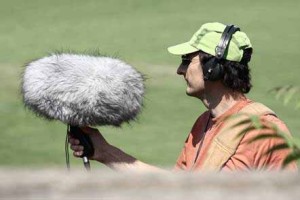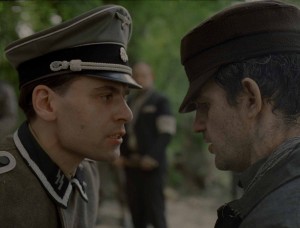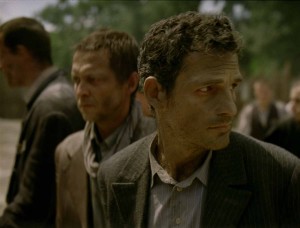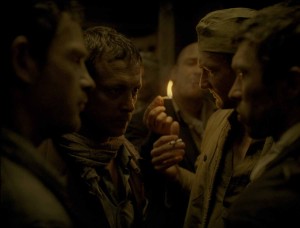
Whether it’s a true account, like Anne Frank’s The Diary of a Young Girl, or a dramatic film, such as Roman Polanski’s The Pianist, personal stories help people comprehend the unfathomable atrocities of the Holocaust. And here we have another tale with Hungarian director László Nemes’ film Son of Saul, a story singly focused on one man’s Holocaust experience. But unlike The Diary of a Young Girl or The Pianist, there is no hiding in Son of Saul. Saul Ausländer (played by Géza Röhrig) is forced to work in the crematorium in Auschwitz-Birkenau concentration camp, burning the bodies of his people day after day. Throughout the film, the camera stays close to Saul, delivering the audience into his own personal hell. And although the field of view is limited, the mind can see what the ear hears.
Son of Saul is Hungary’s submission for the 2016 Academy Award for best foreign language film. Already on the indie festival circuit it’s earned numerous nominations for best feature film and best director, as well as winning a few awards, most notably the 2015 Cannes Film Festival Grand Prix. On Dec. 18, those movie-goers in the US who don’t typically frequent film festivals can experience Nemes’ grim tale in theaters thanks to distribution by Sony Pictures Classics.

During postproduction on Son of Saul, Nemes spent months working closely with sound designer Tamás Zányi, literally sitting beside him in the studio, experimenting with ways of using immersive sound to paint a rich picture of what’s happening off screen, all of course without drawing attention to the technology. “We attempted to assist the storyline in a simple and natural way and convey emotions and atmospheres via sounds. We wanted to depict the sound environment to embrace the viewer,” said Zányi. With the camera trained closely on Saul, Zányi was able to imagine the world beyond the lens. “I have mixed several 5.1 films, but never before did I find the surround sound technology as effective as here. The story seemed to justify the sound. I am really sorry that we could not try Auro-3D or Dolby Atmos – unfortunately these technologies are not yet available in Hungary.”
According to Zányi, nearly 80% of the film’s sound was created during postproduction. To build out each scene, he first reinforced the visuals with hard effects and Foley (provided by Foley artist Tamás Beke). Then, he expanded the sound space by adding human voices and sound effect layers that had no visual match. For example, near the start of the film, Saul is cleaning in the crematorium. Using production sound as the base, Zányi enhanced the scrubbing sounds, and then added voices to fill out the environment. He used panning and processing, including 5.1 surround reverb, to define the space on and off screen. “We recorded a lot of post-sync (ADR) in different languages. We relied very heavily on [actor] Mendy Cahan’s Yiddish input. Various snippets of his sound recordings were applied to the picture. We also multiplied them, changed the pitch, and reused them elsewhere in the film,” Zányi revealed.
 Set in Auschwitz in 1944, the historical period and location both determined and facilitated Zányi’s work. Nemes wanted the sounds and noises of the labor camp to be constantly heard.
Set in Auschwitz in 1944, the historical period and location both determined and facilitated Zányi’s work. Nemes wanted the sounds and noises of the labor camp to be constantly heard.
Zányi said he was very conscious of not making the backgrounds into an independent radio play, but instead, followed the picture slavishly, constantly changing the backgrounds to fit the perspective. “I always watch the visual image before I set to work – with no sound whatsoever. I drew a lot of inspiration from the imagery in this film, from the set design and costumes, from the actor’s performance and the movement of the camera,” said Zányi, who referenced Holocaust documentaries and memoirs, as well as used his own imagination to reconstruct the sound of the crematorium and other places around the concentration camp. His sound design incorporates “shoveling coal, heating the boilers and running them at full capacity, the terrified screams and the banging of the victims on the gas chamber’s walls, the sound of clothes and suitcases being unpacked, the sound of people trudging, and the sounds of people and trains arriving. These are all part of the horrifying image of death camps.”
 Zányi’s biggest challenge for sound design was in making an effective soundtrack without the aid of a music score. In his design, he used musical textures that aren’t perceived as music. For example, in that opening scene where Saul is scrubbing, he witnesses a sick boy being smothered to death, and discerns the dead child to be his son. Zányi chose a composition by Hungarian composer László Melis, and recorded it with a string quintet. During the sound design, Zányi transformed this piece of music into an atmospheric effect, to enhance the mood of the scene. “Such musical textures were used at other points in the film to boost sound effects and charge the atmosphere,” noted Zányi.
Zányi’s biggest challenge for sound design was in making an effective soundtrack without the aid of a music score. In his design, he used musical textures that aren’t perceived as music. For example, in that opening scene where Saul is scrubbing, he witnesses a sick boy being smothered to death, and discerns the dead child to be his son. Zányi chose a composition by Hungarian composer László Melis, and recorded it with a string quintet. During the sound design, Zányi transformed this piece of music into an atmospheric effect, to enhance the mood of the scene. “Such musical textures were used at other points in the film to boost sound effects and charge the atmosphere,” noted Zányi.
Working without music may have been a challenge, but Zányi feels that it also made his life easier. “I was forced to focus on the precise effects of noises, atmospheres and human voices as well as the directions and depths of acoustic spaces,” he said.





